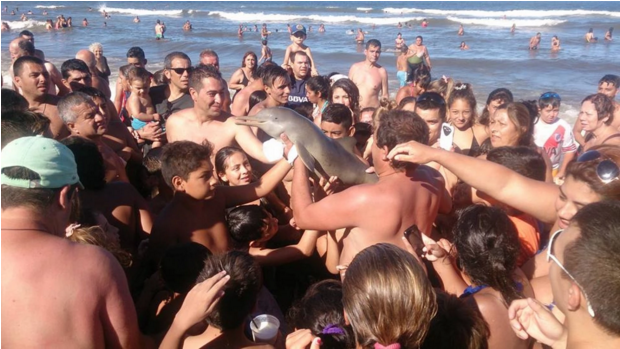By now, you’ve almost certainly seen this photograph, making the viral rounds, of a Franciscana dolphin in South America, attached to headlines like the following: Endangered baby dolphin dies after swimmers pass it around for selfies, A Baby Dolphin Died Because Tourists Wanted Selfies With Her, A selfie mob in Argentina may have killed a dolphin.

I hate these news stories, but not for the reasons you might think.
These stories represent a kind of technological puritanism in ocean outreach, where we draw weirdly unfounded conclusions about the way humans relate to their tools to somehow absolve us of social responsibility. It’s not people mistreating a dolphin, it’s a selfie-crazed mob. We chuckle and move on, because we don’t take aggressive selfies. We’re better than that.
This is not correct.
I know it’s not correct because, admit it, you shared one of those articles. You jumped into a social media mob to pass around this image as if it were some kind of statement about how horrible selfies are. Yes, even you. And if you didn’t, I bet you’re feeling pretty smug about not jumping in on that one. Catch-22.
As an aside, because I am the saltiest of salty ocean bloggers, I would be remiss if I didn’t ask: where is the selfie? I see two cameras among this crowd of a couple dozen people, plus the camera taking this picture. None of them appear to be taking selfies.
Here’s what I know: We need to do a better job educating people about handling marine animals, these kinds of things happen a lot, and they happen whether or not someone is there to take pictures. We need to train lifeguards or beach staff to handle marine animal standings. We need to post more signs. And we need to spend more time thinking about how to use incidents like this to broaden people’s understanding of marine life. After all, that crowd is comprised mostly of children who are simply curious, rather than cruel.
People don’t participate in exceptionally cruel acts because they have a camera. People participate, often unknowingly, in exceptionally cruel acts and, because everyone has a camera, these acts are documented. Pretending it’s technology that drives crowds to drag an ailing dolphin out of the surf and pass it around like a trophy, fundamentally misses something important about human behavior and refocuses conservation conversations on trivialities like cracking wise about selfie-sticks rather than addressing clear and critical knowledge gaps. We need to be fostering both an appreciation for and understanding of the ocean, and yes, absolutely that involves connecting people to the ocean through photography, even *gasp* selfies.
If nothing else, this kind of technological puritanism misses the most important message in this moment. We only know it happened, we are only now able to discuss it, because someone took a picture.